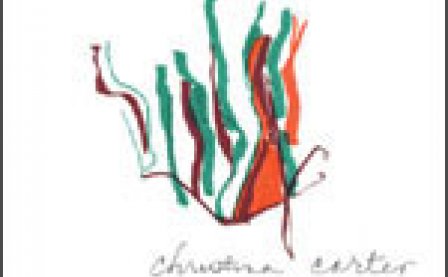Living Contact, the recent Kranky release from Christina Carter (of Charalambides and Scorces fame) is about as lo-fi as the term lo-fi gets. A reissue of Christina Carter's first record which was recorded back in the mid-1990s, it's indicated by Kranky in the album's press materials that this solo material was recorded on boom box and four track tape. There is a definite and clear distinction between the boom box-recorded pieces and the four-tracks. A varying abundance of tape hiss, warble, and muted, monophonic production causes these pieces to stand out prominently, yet the notable thing about each of these tracks is Ms. Carter's uncanny ability to improvise. That she can hit "record" on a boom box and lay into a beautiful piece that resonates with passion in its simplicity is a testament to Christina Carter's skill as a musician, as well as her musical contribution to her two other bands.
Although the album is purely comprised of solo acoustic guitar and a few wordless vocals, the spirit of the pieces presented here is one of sonic experimentation. There is a freshness and vitality to these timeless tracks -- they could have been recorded in the 1930s, or maybe last week. At any rate, each is an engaging piece which ensnares the listener, challenging her to discern which direction the music is next going to take.
When Ms. Carter focuses on melody rather than overt experimentation, both her playing style and the music she creates are absolutely lovely. For the most part, there is a sense of sorrow and loneliness conveyed by these pieces. "Going Down," for instance, is a dissonant, minor-key track that is hypnotizing, mesmerizing, and beautiful. Although Living Contact is a primarily instrumental record with precious few vocals by Ms. Carter, her ethereal yet coldly detached voice adds an eerie depth to the music. Her ghostly wails on "Alone, Not Alone" complement the dusty, creaky sadness she manages to squeeze out of her guitar. The album's centerpiece, this 14-minute track is shrouded in lo-fi tape hiss, incidental background ambience, and fret buzz, adding a sense of antiquity and poignant spontaneity to the track. Rather than mar the production, these sonic accoutrements add to it a sense of candor and simplicity.
Haunting and grainy, Living Contact essentially sounds like a compendium of field recordings. Lacking the cohesion of a proper studio album, the pieces become increasingly more abstract as the album progresses. Much of the record seems like incidental music for a soundtrack (not unlike some Popol Vuh scoring of a Werner Herzog film, or perhaps a more experimental Ry Cooder scoring an indie western). The imagery, which is quite vividly conveyed here, is that of desert and pastoral landscapes. There is also a sense of ritual drone and ur-blues to the music on Living Contact. The pieces progress very slowly, adding to the melancholy ambience with which the music is infused. More than just a simple curiosity, Living Contact is an important contribution to the Charalambides-and-related canon.
1. Silhouette
2. Dream Mother
3. Alone, Not Alone
4. Going Down
5. Body Energy Exchange
6. Major
More about: Christina Carter



